Best known as the landing place of the Pilgrims and the Mayflower, Massachusetts also boasts a wonderful contingent of bird enthusiasts who trace their heritage to one of the pioneers in the field of ornithology known as Ludlow Griscom. Ludlow was buried in Cambridge’s Mount Auburn Cemetery, one of Massachusetts’ most famous birding sites.
There are around 448 species of birds in Massachusetts. Several hawks bear the state’s name to recognize its importance in their ranges among these species. They inhabit rocky shores, marshy areas, mountainous regions, sandy beaches, and dense forests within the state. Below, we will look at 8 types of hawks that call Massachusetts home.
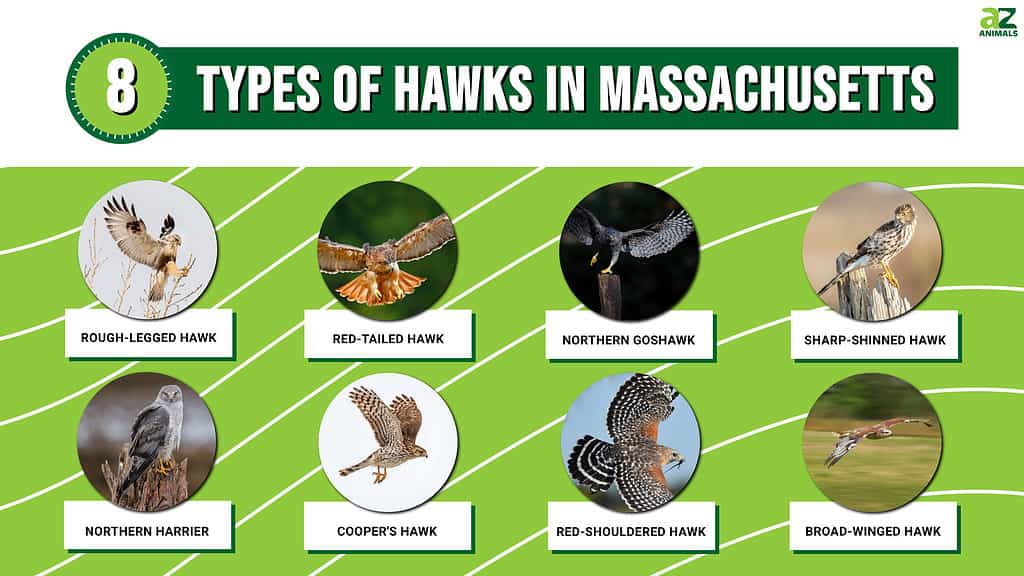
From the curving arm of Cape Cod to the Parker River National Wildlife Refuge, you will be able to see numerous types of hawks soaring in the skies or perched up on poles. Make the most of your time in Massachusetts by visiting some of the top local destinations for hawks.
1. Rough-legged Hawk
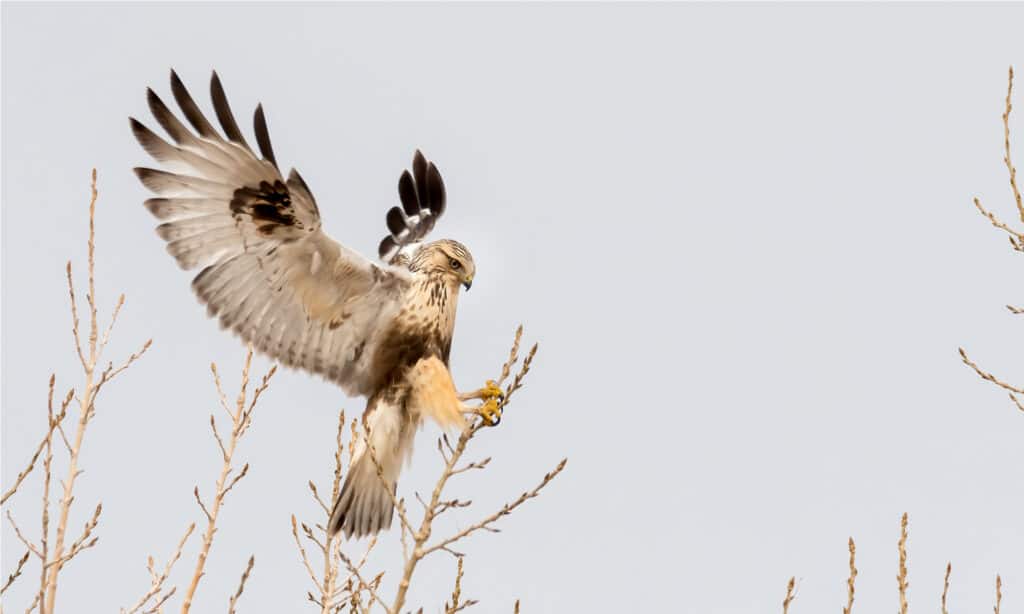
Rough-legged hawks have chunky bodies, tiny feet, broad wings, and elongated bodies.
©Eivor Kuchta/Shutterstock.com
| Rough-legged Hawk | |
|---|---|
| Scientific name | Buteo lagopus |
| Weight | 1.32-3.66 lbs (599-1660 g) |
| Height | 18-24 in (46-60 cm) |
| Wingspan | 52-54 in (132-138 cm) |
Named for their feathered legs, rough-legged hawks are not very common in Massachusetts, except during winter. Of all the soaring buteo hawks, rough-legged hawks are the only ones tied to cold climates. They are often spotted perched on poles or hovering over open fields and marshes during winter.
Rough-legged hawks have chunky bodies, tiny feet, broad wings, and elongated bodies. They fan their tails while soaring in the skies. They are grayish-brown on top, with brown markings on their whitish underparts.
Their diet consists of voles, lemmings, songbirds, shorebirds, waterfowl, shrews, mice, ground squirrels, large insects, and many other small mammals. They hunt almost exclusively by hovering over open fields and occasionally perch to watch prey movements. They sometimes pick road-killed animals.
These raptors breed mainly in the Arctic, usually in tundra regions. They build their nests either on a high cliff or on a narrow ledge. Their main aim is to get a site that offers a broad view of the environment.
Females lay between 3 and 5 eggs. The incubation lasts for about 30 days, and the males may help incubate the eggs when the female is briefly out of the nest. Young ones begin to fly at around 5–6 weeks.
2. Red-tailed Hawk
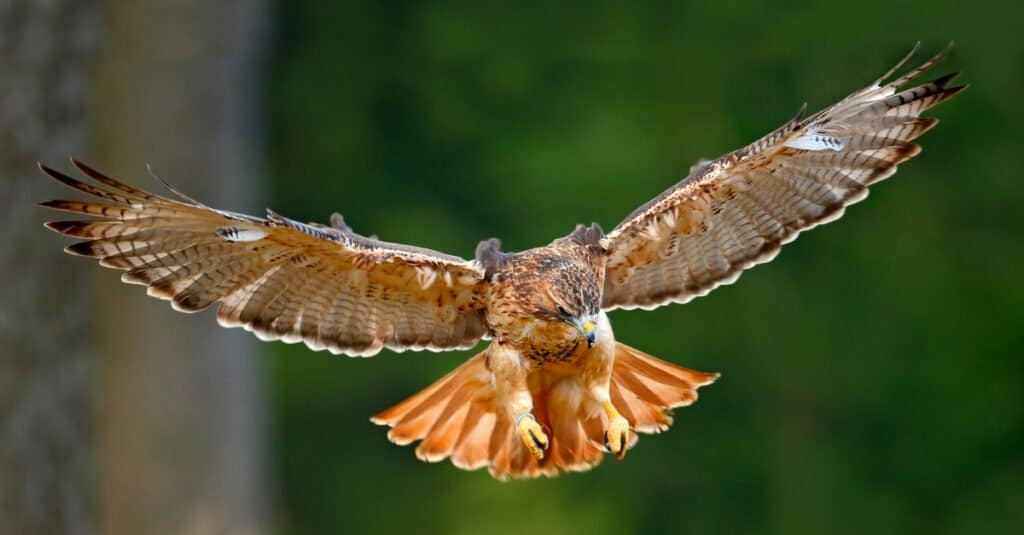
Red-tailed hawks mainly feed on mice and rats.
©Ondrej Prosicky/Shutterstock.com
| Red-tailed Hawk | |
|---|---|
| Scientific name | Buteo jamaicensis |
| Weight | 1.5-3.5 lbs (680-1586 g) |
| Height | 18-26 in (45-65 cm) |
| Wingspan | 43-56 in (110-141 cm) |
Red-tailed hawks are commonly sighted in Massachusetts throughout all seasons. They are often found on the roadsides, plains, mountains, prairies, and mountains. They live in any habitat that provides open fields for hunting and some tall perches to watch for prey.
Red-tailed hawks mainly feed on mice and rats, which is quite beneficial to farmers, who are usually troubled by rodents. On some occasions, they also eat ground squirrels, rabbits, toads, lizards, snakes, fish, and other small-to-medium-sized animals.
These hawks nest on cliff ledges, tall trees, artificial structures like tall buildings, and sometimes even among the arms of giant cactus. Females lay between 2 and 3 eggs. Incubation takes around 28–35 days. Both sexes take turns incubating the eggs. Young ones leave the nest in about 6-7 weeks after hatching.
3. Northern Goshawk

The northern goshawk’s diet consists of crows, grouse, rabbits, snakes, insects, rodents, squirrels, and snowshoe hares.
©Henk Bogaard/Shutterstock.com
| Northern Goshawk | |
|---|---|
| Scientific name | Accipiter gentilis |
| Weight | 1.4-4.8 lbs (635-2177 g) |
| Height | 18-27 in (46-69 cm) |
| Wingspan | 40-46 in (103-117 cm) |
Northern goshawks are found in Massachusetts year-round. They tend to inhabit both deciduous and coniferous forests but can still be virtually found in any type of woodland as long as it’s not dense. These raptors usually avoid dense forests.
They are medium-sized hawks with mottled white, gray, and black feathers. Most of them have bright red eyes. They are very secretive and shy birds of prey, but they are extremely loud when it comes to defending their nests from intruders. They aggressively chase animals, even those that are more significant than themselves.
These hawks have a diet that consists of crows, grouse, rabbits, snakes, insects, rodents, squirrels, and snowshoe hares. They don’t normally chase after prey but prefer to launch an attack on an unsuspecting bird.
Northern goshawks build their nests at the major crotches of deciduous trees in mixed forests. Females lay between 2-5 bluish-white eggs when the nests are ready. The incubation period lasts for 32-38 days. Young ones start flying at around 5-6 weeks.
4. Sharp-shinned Hawk
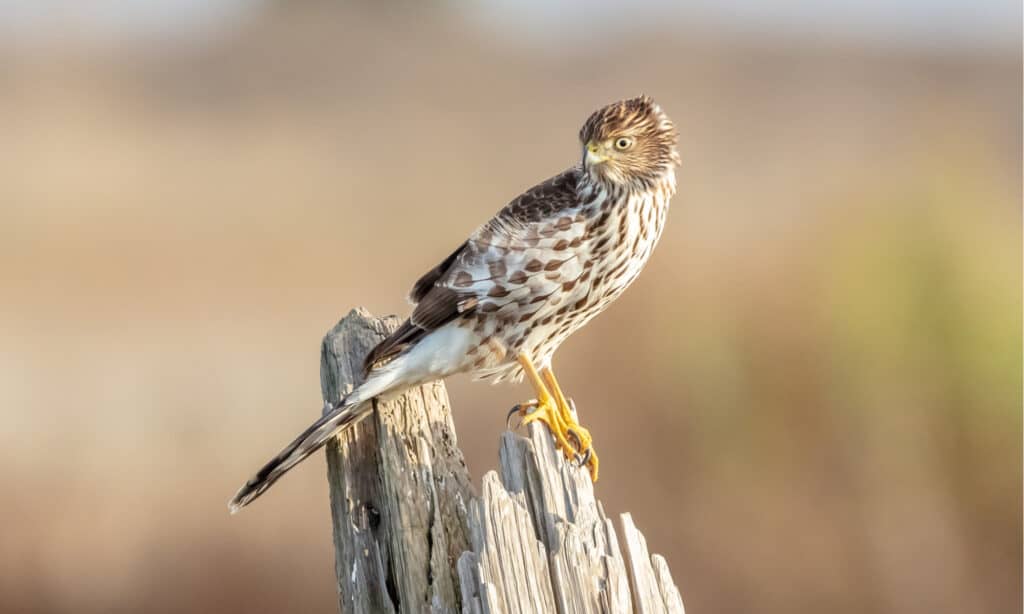
Sharp-shinned hawks live in a wide range of habitats, including forest edges, open deciduous woodlands, and coniferous forests.
©Pierre Leclerc/Shutterstock.com
| Sharp-shinned Hawk | |
|---|---|
| Scientific name | Accipiter striatus |
| Weight | 2.9-7.7 oz (82-219 g) |
| Height | 9.1-15 in (23-37 cm) |
| Wingspan | 17-27 in (42-68 cm) |
Sharp-shinned hawks are probably the smallest hawks in Massachusetts. They are not very common in the state but can be found year-round. They live in a wide range of habitats, including forest edges, open deciduous woodlands, and coniferous forests. They tend to avoid open habitats, even during winter.
These hawks are slaty blue-gray on top with red-orange bars on their underneath. Their young ones are mostly brown with some vertical streaks on their underparts. Both adults and immature hawks have dark-banded long tails.
The diet of sharp-shinned hawks consists mainly of small birds and rodents. They also feed on toads, frogs, lizards, and insects. They either hide in foliage and wait for small birds to approach or watch the prey from perches.
Sharp-shinned hawks prefer taking prey by surprise rather than chasing after it—they nest in the forest, usually in dense conifers. Females lay between 4 and 5 eggs, which take about 30–35 days to hatch. Females are in charge of incubation, while males provide food for them during this period. Young ones begin to fly at about 5–6 weeks.
5. Northern Harrier

Northern harriers are either brown or gray on top, with whitish undersides.
©Harry Collins Photography/Shutterstock.com
| Northern Harrier | |
|---|---|
| Scientific name | Circus hudsonius |
| Weight | 11-27 oz (300-750 g) |
| Height | 21-25 in (53-64cm) |
| Wingspan | 41-46 in (103-117 cm) |
Northern harriers are very common in Massachusetts during winter but can be found during all seasons. They inhabit the prairies, fields, or marshes. They live in both dry and wet habitats, preferably in open terrain with excellent ground cover.
Northern harriers are either brown or gray on top, with whitish undersides. Both the immature hawks and adults have black-banded tails. The only difference is that the young ones have buffy underparts and less streaked underparts.
Their diet consists of small birds, rats, voles, large insects, frogs, toads, snakes, carrion, and small rabbits. They hunt by hovering over open fields. They also locate prey by sound.
Northern harriers nest in marshes or dense areas. Females are the ones who build the nests, while males supply the nesting materials. Females lay between 4 and 6 eggs, which take about 30–32 days to hatch.
6. Cooper’s Hawk

Cooper’s hawks feed on mice, bats, tree squirrels, ground squirrels, chipmunks, reptiles, and insects.
©Richard G Smith/Shutterstock.com
| Cooper’s Hawk | |
|---|---|
| Scientific name | Accipiter cooperii |
| Weight | 7.8-14.5 oz (220-410 g) |
| Height | 14-20 in (35-50 cm) |
| Wingspan | 24-39 in (62-99 cm) |
Cooper’s hawks are often sighted in Massachusetts year-round. They inhabit the river groves, wood edges, and open woodlands. These medium-sized hawks resemble sharp-shinned hawks in many ways, but they are more significant. They are blue-gray above with reddish bars on their underneath.
These hawks have a diet that consists mainly of small mammals and medium-sized birds. They feed on mice, bats, tree squirrels, ground squirrels, chipmunks, reptiles, and insects, among many others. Also, they prefer hunting in dense cover by moving from one perch to another as they watch and listen to any sounds of prey. Cooper’s hawks are vulnerable to predation by great-horned owls, raccoons, and red-tailed hawks.
Cooper’s hawks build their nests on top of trees in deciduous or coniferous forests. Females lay between 3–5 pale-bluish-whitish eggs, which take approximately 34–36 days to hatch. Young ones start flying at around 4–5 weeks.
7. Red-shouldered Hawk
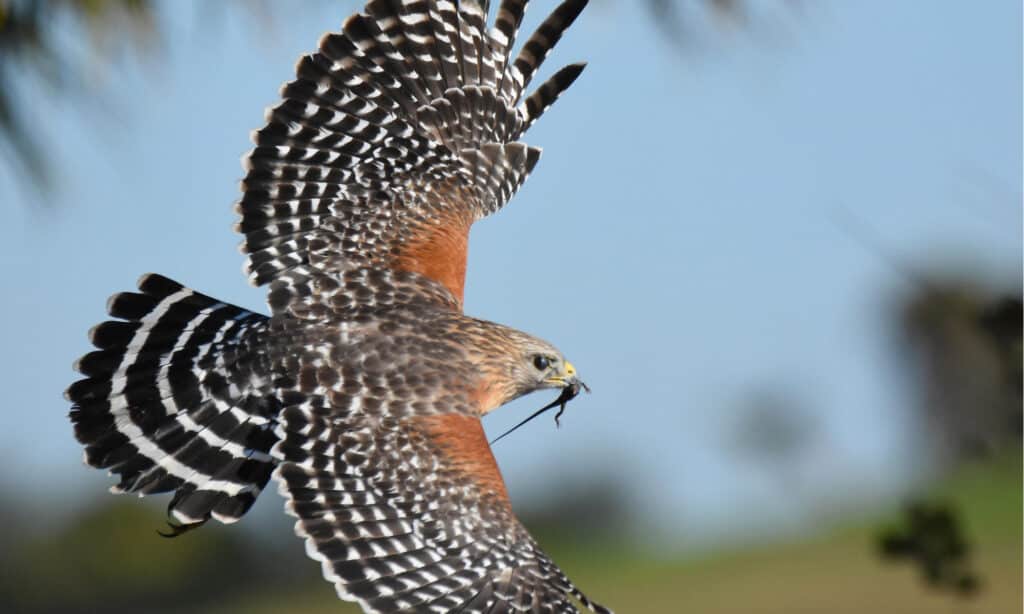
Red-shouldered hawks build their nests in deciduous or coniferous trees.
©MTKhaled mahmud/Shutterstock.com
| Red-shouldered Hawk | |
|---|---|
| Scientific name | Buteo lineatus |
| Weight | 1-1.7 lbs (486-774g) |
| Height | 15-24 in (38-61 cm) |
| Wingspan | 35-50 in (90-127 cm) |
Red-shouldered hawks can be found throughout Massachusetts seasons. They inhabit the swamps, wooded streamsides, and bottomland woods. They shift to more open habitats during winter. They are named after the reddish barring they have on the breast.
These hawks have a diet that consists of small birds, chipmunks, voles, toads, frogs, crayfish, snakes, and large insects. They either hunt by flying low in an open field or may opt to watch for prey from a perch. They use their hearing abilities and sharp sight to locate prey.
Red-shouldered hawks build their nests in deciduous or coniferous trees. Females usually lay 3–4 eggs. The incubation period lasts approximately 33 days. Young birds begin to fly in 5–7 weeks.
8. Broad-winged Hawk
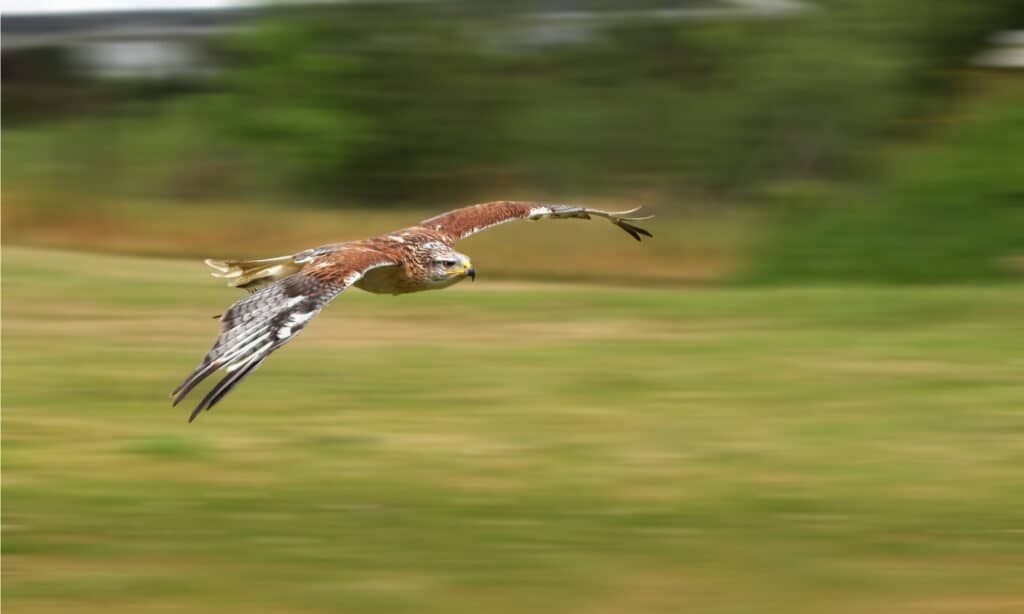
The broad-winged hawk’s diet consists of squirrels, voles, mice, young turtles, lizards, frogs, toads, and small birds.
©pr2is/Shutterstock.com
| Broad-winged Hawk | |
|---|---|
| Scientific name | Buteo platypterus |
| Weight | 9.3-19.8 oz (264-561 g) |
| Height | 13.4-17.3 in (34-44 cm) |
| Wingspan | 31.9-39.4 in (81-100 cm) |
Broad-winged hawks are found more often in the northern parts of Massachusetts. Get the best chance to see them by visiting the state when these raptors migrate during the fall. They inhabit the groves and woods but breed in deciduous or coniferous forests. They have reddish-brown heads with black-and-white banded tails.
Their diet consists of squirrels, voles, mice, young turtles, lizards, frogs, toads, and small birds. They hunt by flying through the woods or may watch for prey from a perch. They swoop down rapidly to capture prey as soon as they spot it.
Once these hawks complete building their nests in large coniferous or deciduous trees, they are ready for breeding. Females lay between 2–3 eggs, which take around 28–31 days to hatch. Young ones may begin flying as early as 5–6 weeks of age.
Summary of 8 Types of Hawks in Massachusetts
| Name | Habitat | Prey |
|---|---|---|
| Rough-legged Hawk | Open fields and marshes in winter; breed in Arctic tundra. | Voles, lemmings, songbirds, shorebirds, waterfowl, shrews, mice, ground squirrels, large insects, and many other small mammals. |
| Red-tailed Hawk | Plains, mountains, prairies, and mountains; open areas. | Mainly mice and rats. |
| Northern Goshawk | Deciduous and coniferous forests, and dense woods. | Crows, grouse, rabbits, snakes, insects, rodents, squirrels, and snowshoe hares. |
| Sharp-shinned Hawk | Forest edges, open deciduous woodlands, and coniferous forests. | Toads, frogs, lizards, and insects. |
| Northern Harrier | Prairies, fields, or marshes. | Small birds, rats, voles, large insects, frogs, toads, snakes, carrion, and small rabbits. |
| Cooper’s Hawk | River groves, wood edges, and open woodlands. | Mice, bats, tree squirrels, ground squirrels, chipmunks, reptiles, and insects. |
| Red-shouldered Hawk | Swamps, wooded streamsides, and bottomland woods; open areas in winter. | Small birds, chipmunks, voles, toads, frogs, crayfish, snakes, and large insects. |
| Broad-winged Hawk | Groves and woods; breed in deciduous or coniferous forests. | Squirrels, voles, mice, young turtles, lizards, frogs, toads, and small birds. |
The photo featured at the top of this post is © Jesus Giraldo Gutierrez/Shutterstock.com
Thank you for reading! Have some feedback for us? Contact the AZ Animals editorial team.






